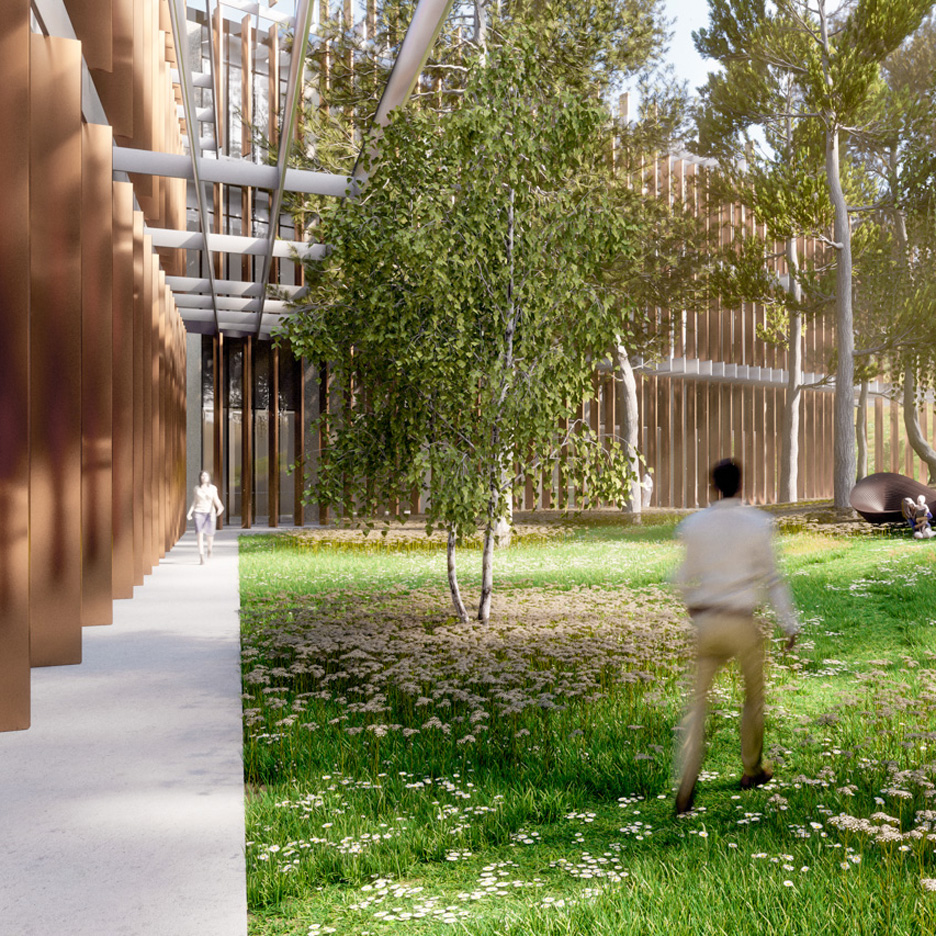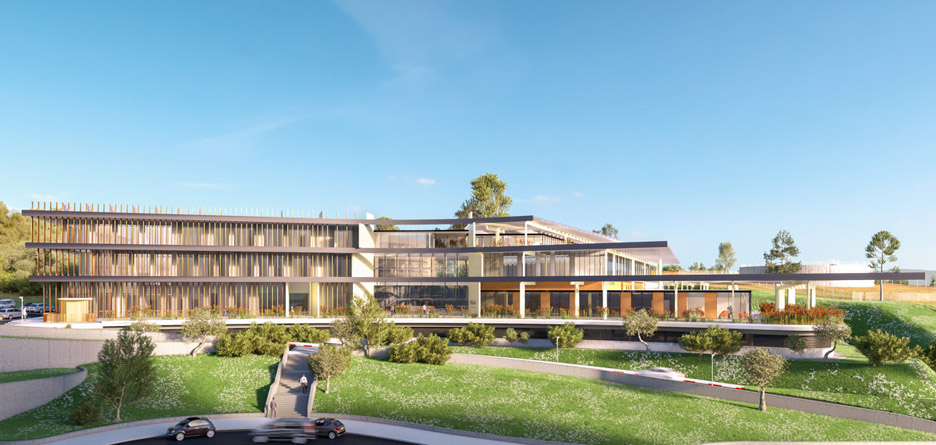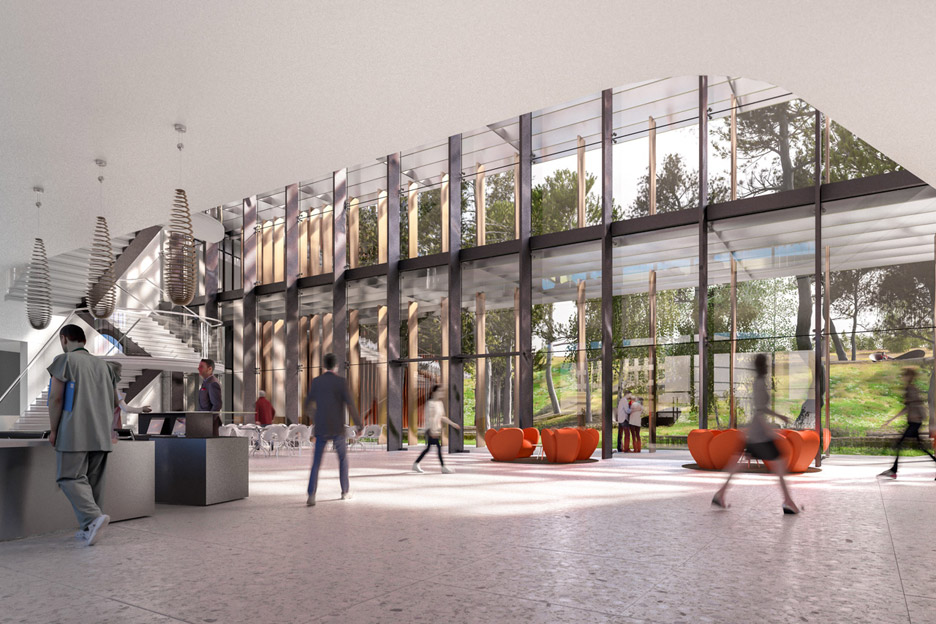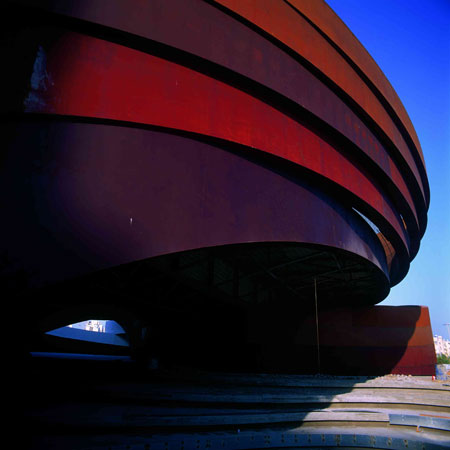"Architects have a duty to do good things" says Ron Arad
Conflict areas like the West Bank offer opportunities for architects to combine their design ambitions with a desire to make a difference in the world, according to Ron Arad (+ interview).
The London-based Israeli designer has just unveiled plans to build a cancer treatment centre in northern Israel, which will serve Jewish, Christian, Muslim and Druze communities in both Israeli and Palestinian territories.
"Architects have a duty to do good things," explained Arad, 64, in an exclusive interview with Dezeen.
"There are some places that I would avoid and refuse to take jobs," he said. "But there are some places where not only is your eagerness to do architecture satisfied, but also your eagerness to do good, and this one is a perfect example of that."
Proposed for the existing Ha-Emek Medical Centre, Beit Shulamit will for the first time offer cancer sufferers in West Bank cities like Jenin and Nablus access to specialist treatment.

"Luckily Ha-Emek understands that sometimes you have to invest in things that normally there isn't enough money for," he said.
Ron Arad trained as an architect at the Architectural Association in London, although he moved into industrial design after discovering a Rover car seat in a local scrapyard and transforming into the iconic Rover Chair in 1981.
The designer said he regularly turns down offers of architectural projects in "dark regimes", and claimed most architects have enough common sense to know the difference between the projects they should and shouldn't take on moral grounds.
"Most architects I know are very idealistic people," he said. "It's a very tough profession and they need to do jobs to keep their practices busy and thriving. So it becomes a question of how much people compromise."

See the full transcript of our interview with Ron Arad below:
Amy Frearson: How did the Beit Shulamit project come about?
Ron Arad: It was because of a great lady called Shulamit Katzman. She was a children's doctor, but she also had a passion for art and was the head of the Board of Trustees at Design Museum Holon. Sadly she passed away, and her husband decided to build a cancer ward in her name.
He made the decision to build it in a place that is not one of the main cities, so not Tel Aviv or Jerusalem, he wanted it in an area that would cater for both Israelis and Palestinians. So he chose Afula because, even though it is in the north of Israel, it's not too far from cities like Jenin and other villages. It was idealistic – he not only wanted to do a hospital, he had other ideas. And he wanted me to be the architect of the project, so here I am.
The only problem was that the hospital had already talked to another firm of architects called Mochly-Eldar. I didn't want to step on colleagues' feet, but when I talked to them they weren't upset, they were delighted. It was a fantastic blind date, and we were such a good team together. They also have more experience in designing hospitals than me – I have no experience in designing hospitals. So it's a really good collaboration.
Amy Frearson: How did you approach the design, especially given the sensitivity of the location?
Ron Arad: We chose a location that is on the outer ring of the hospital – a very nice hill that still is connected to the hospital. And now, in our project, there will be tunnels and bridges and things.
And then we had very intense brainstorming sessions with the doctors, nurses and everyone involved. We heard one thing and its opposite; the main thing people wanted was privacy, but another person said the main thing was for it to be a place that makes you feel like you're not alone. I understand both, so putting them together was what we did.
I also wanted freedom from the horrible hospital corridors, so we allowed the outdoors to play a big part. At any point you have amazing views of the outside. In a way, the rooms are outdoors and the bedrooms are the spaces around them.
It is a very rewarding project to work on. You know what your objectives are: the welfare of the patients, the families, and the staff. These objectives don't work against the architecture; they work with it.

Amy Frearson: What do you think are the biggest challenges you are going to face in this project?
Ron Arad: Making a place that helps people in not very happy parts of their lives, and that includes all sorts of people. The challenge is doing what everyone wants to do when they design a hospital – to make the best possible place for the people who use it. Luckily Ha-Emek understands that sometimes you have to invest in things that normally there isn't enough money for.
Amy Frearson: Do you think architects have a moral responsibility to work in troubled areas, and conflict zones in particular?
Ron Arad: I think that architects can't be choosers. But architects have a duty to do good things, like any other good citizen. And yes there are some places that I would avoid and refuse to take jobs. But there are some places where not only is your eagerness to do architecture satisfied, but also your eagerness to do good, and this one is a perfect example of that.
Amy Frearson: Have you ever refused to work in any places on moral grounds?
Ron Arad: Yes, we do it all the time.
Amy Frearson: Can you tell me where?
Ron Arad: Sorry no, I don't want to.
Amy Frearson: Do you think more architects should engage with humanitarian issues?
Ron Arad: Most architects I know are very idealistic people. It's a very tough profession and they need to do jobs to keep their practices busy and thriving. So it becomes a question of how much people compromise. But the people I know are generally on the right side of things. I don't know that much about people who build in dark regimes.

Amy Frearson: Do you think there’s enough emphasis on these issues in architectural education? Are students prepared enough when they start in the industry?
Ron Arad: I think that people generally can tell between things that you should absolutely be involved with, and things you should avoid. At least in my experience, in the education I received and in the education I was in charge of at the Royal College, yes we definitely did a lot to do good.
Recently of course, environmental issues have became something that people put on the flag, which is of course very important. If it becomes trendy, if green issues become selling points, that's OK.
Amy Frearson: Having grown up in Tel Aviv, how important is it for you to be back working on another major project in Israel, six years after you completed the Design Museum Holon?
Ron Arad: Every project we do is important on a personal level. For instance, we're also working on the Watergate Hotel in Washington, where the Watergate scandal happened. I would be telling you a lie if I didn’t tell you that part of the attraction to do the job was the legacy, and our take on it.
Amy Frearson: There seems to be a trend of design studios moving more and more into architecture. Would you say architecture is becoming more important for your studio than it was before?
Ron Arad: No that's not the case with us. We have a studio that doesn't rely on getting more and more jobs, whatever they are, because we can keep ourselves busy in other ways. We are very choosy about the projects we do, but the architectural practice has been very busy for a long time. So moving more towards architecture isn't a plan.